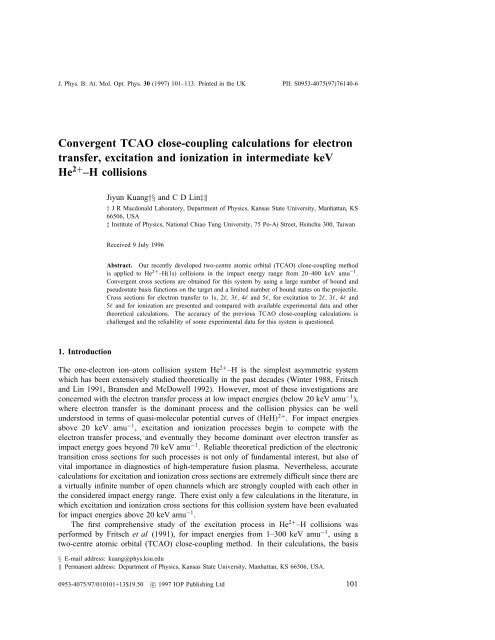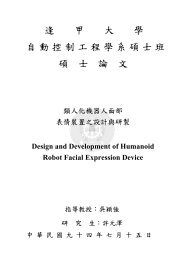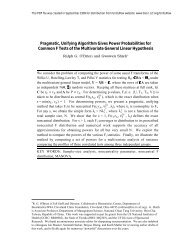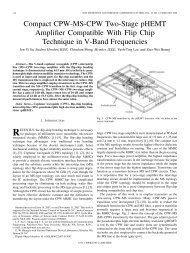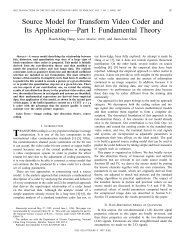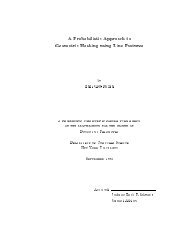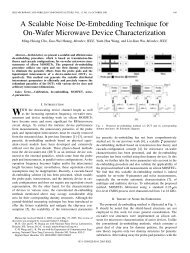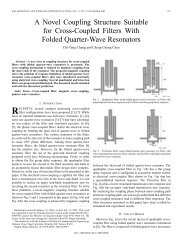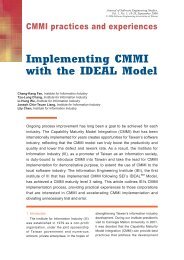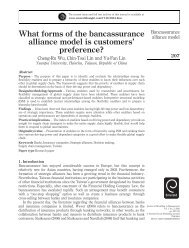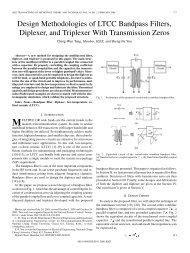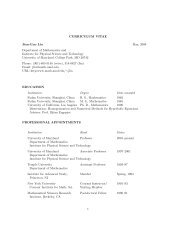J. Phys. B: At. Mol. Opt. Phys. 30
J. Phys. B: At. Mol. Opt. Phys. 30
J. Phys. B: At. Mol. Opt. Phys. 30
You also want an ePaper? Increase the reach of your titles
YUMPU automatically turns print PDFs into web optimized ePapers that Google loves.
J. <strong>Phys</strong>. B: <strong>At</strong>. <strong>Mol</strong>. <strong>Opt</strong>. <strong>Phys</strong>. <strong>30</strong> (1997) 101–113. Printed in the UK PII: S0953-4075(97)76140-6<br />
Convergent TCAO close-coupling calculations for electron<br />
transfer, excitation and ionization in intermediate keV<br />
He 2+ –H collisions<br />
Jiyun Kuang†§ and C D Lin‡‖<br />
† J R Macdonald Laboratory, Department of <strong>Phys</strong>ics, Kansas State University, Manhattan, KS<br />
66506, USA<br />
‡ Institute of <strong>Phys</strong>ics, National Chiao Tung University, 75 Po-Ai Street, Hsinchu <strong>30</strong>0, Taiwan<br />
Received 9 July 1996<br />
Abstract. Our recently developed two-centre atomic orbital (TCAO) close-coupling method<br />
is applied to He 2+ –H(1s) collisions in the impact energy range from 20–400 keV amu −1 .<br />
Convergent cross sections are obtained for this system by using a large number of bound and<br />
pseudostate basis functions on the target and a limited number of bound states on the projectile.<br />
Cross sections for electron transfer to 1s, 2l, 3l, 4l and 5l, for excitation to 2l, 3l, 4l and<br />
5l and for ionization are presented and compared with available experimental data and other<br />
theoretical calculations. The accuracy of the previous TCAO close-coupling calculations is<br />
challenged and the reliability of some experimental data for this system is questioned.<br />
1. Introduction<br />
The one-electron ion–atom collision system He 2+ –H is the simplest asymmetric system<br />
which has been extensively studied theoretically in the past decades (Winter 1988, Fritsch<br />
and Lin 1991, Bransden and McDowell 1992). However, most of these investigations are<br />
concerned with the electron transfer process at low impact energies (below 20 keV amu −1 ),<br />
where electron transfer is the dominant process and the collision physics can be well<br />
understood in terms of quasi-molecular potential curves of (HeH) 2+ . For impact energies<br />
above 20 keV amu −1 , excitation and ionization processes begin to compete with the<br />
electron transfer process, and eventually they become dominant over electron transfer as<br />
impact energy goes beyond 70 keV amu −1 . Reliable theoretical prediction of the electronic<br />
transition cross sections for such processes is not only of fundamental interest, but also of<br />
vital importance in diagnostics of high-temperature fusion plasma. Nevertheless, accurate<br />
calculations for excitation and ionization cross sections are extremely difficult since there are<br />
a virtually infinite number of open channels which are strongly coupled with each other in<br />
the considered impact energy range. There exist only a few calculations in the literature, in<br />
which excitation and ionization cross sections for this collision system have been evaluated<br />
for impact energies above 20 keV amu −1 .<br />
The first comprehensive study of the excitation process in He 2+ –H collisions was<br />
performed by Fritsch et al (1991), for impact energies from 1–<strong>30</strong>0 keV amu −1 , using a<br />
two-centre atomic orbital (TCAO) close-coupling method. In their calculations, the basis<br />
§ E-mail address: kuang@phys.ksu.edu<br />
‖ Permanent address: Department of <strong>Phys</strong>ics, Kansas State University, Manhattan, KS 66506, USA.<br />
0953-4075/97/010101+13$19.50 c○ 1997 IOP Publishing Ltd 101
102 Jiyun Kuang and CDLin<br />
set consists of 23 projectile-centred bound/pseudostates and 31 target-centred bound/pseudostates<br />
(referred as He23H31 hereafter). The calculated excitation cross sections to 2l<br />
and 3l show pronounced structures around 60 keV amu −1 . Their predicted structures,<br />
interestingly, appeared to have been confirmed experimentally by Hughes et al (1994)<br />
and Donnelly et al (1991) from observing Lyman alpha and Balmer alpha emissions,<br />
respectively. However, this kind of structure for excitation to 2l is absent in a smaller<br />
size close-coupling calculation by Bransden et al (1983), using a single-centred basis set<br />
of 19 target-centred bound/pseudostates for impact energies above 75 keV amu −1 . Below<br />
75 keV amu −1 , their basis set was supplemented by projectile-centred 1s, 2s and 2p states.<br />
Later, Errea et al (1992) successfully extended their MO approach, modified with a common<br />
translational factor for this system, to high impact energies up to <strong>30</strong>0 keV amu −1 . Their<br />
evaluated excitation cross sections to n = 2 and 3 do not have pronounced structures above<br />
35 keV amu −1 . But they did not publish partial excitation cross sections to 2l and 3l.<br />
Experimentally, excitation cross sections to np states have been reported by Detleffsen et al<br />
(1994) using the optical method. Their data do not appear to have any structure, though the<br />
data have large error bars. We consider these structures in excitation cross sections around<br />
60 keV amu −1 to be difficult to understand. <strong>Phys</strong>ically, all structures in the integrated cross<br />
sections have to originate from some competing physical mechanisms, such as the minima<br />
in the excitation cross sections in H + –H collision at about 10 keV amu −1 , which results<br />
from the competition between rotational coupling and radial coupling. As a matter of fact,<br />
the physical structures should be independent of the basis set used in calculations. In other<br />
words, we believe that the structures in the excitation cross sections to 2l and 3l states<br />
above 20 keV amu −1 in He 2+ –H collision remain to be understood both theoretically and<br />
experimentally.<br />
There have been a few coupled channel calculations regarding ionization and electron<br />
transfer cross sections in He 2+ –H collision in the intermediate impact energy region.<br />
Winter (1988) used a triple-centre expansion to evaluate these two cross sections at impact<br />
energies below 50 keV amu −1 . His ionization cross sections overestimated the experimental<br />
data (Shah et al 1988) by about 10–<strong>30</strong>%. Our own group (Shingal and Lin 1989)<br />
performed TCAO close-coupling calculations for this system in the impact energy range<br />
from 2–900 keV amu −1 , using a basis set of 20 projectile-centred and 22 target-centred<br />
bound/pseudostates (He20H22). The calculated ionization cross sections fall below the<br />
experimental data (Shah and Gilbody 1981) at higher energies. Recently, Toshima (1994)<br />
performed large size TCAO close-coupling calculations for a multiply charged ion colliding<br />
with atomic hydrogen in the energy range from 1–400 keV amu −1 . For He 2+ –H collision, he<br />
used a basis set consisting of 96 projectile-centred and 100 target-centred bound/pseudostates<br />
(He96H100). He only published ionization and charge transfer cross sections, which are in<br />
good agreement with the experimental data. However, his ionization cross section seems to<br />
vary not very smoothly with energy at higher impact energies.<br />
The structures discussed above are not specific only to the He 2+ –H collision. In fact,<br />
they appear in many two-centre atomic orbital (TCAO) close-coupling calculations for<br />
other collision systems. Recently, we have investigated this problem for H + –H collision at<br />
impact energies of 5 keV and above (Kuang and Lin (1996a, b), to be referred to as papers<br />
A and B, respectively). We have demonstrated that the spurious oscillatory structures in<br />
previous large-scale TCAO close-coupling calculations for H + –H collision are due to the<br />
simultaneous use of the short-ranged pseudo-continuum states on both collision centres. It<br />
is shown that reliable excitation cross sections can only be obtained with a large number<br />
of basis states on the target and a limited number of bound states on the projectile. In<br />
other words, structures in the excitation cross sections of H + –H collision are artificial and
Convergent TCAO close-coupling for He 2+ –H collisions 103<br />
basis dependent. We believe that the same reason should explain the structures seen in<br />
the calculations by Fritsch et al (1991) for the He 2+ –H system despite these structures<br />
having been ‘confirmed’ by experiments (Hughes et al 1994, Donnelly et al 1991). It is<br />
the goal of the present paper to examine this problem theoretically and at the same time to<br />
provide reliable cross sections for electron transfer to 1s, 2l, 3l, 4l and 5l, for excitation<br />
to 2l, 3l, 4l and 5l and for ionization at impact energies of 20–400 keV amu −1 .<br />
2. Basis sets and the TCAO close-coupling method<br />
As in paper A, the even-tempered basis set (Reeves 1963) is used in the present study. Each<br />
function in such a basis set consists of an exponential multiplied by a solid harmonic, i.e. a<br />
spherical harmonic multiplied by r l . A set of even-tempered basis functions is thus defined<br />
as<br />
χ klm (r) = N l (ζ k ) e −ζkr Y lm (r) Y lm (r) = r l Y lm (ˆr) (1)<br />
where N l (ζ k ) is a normalization constant, and the orbital exponents, ζ k , are taken to form a<br />
geometric sequence ζ k = αβ k ,k=1,2,...,N, where the two parameters α and β can be<br />
determined by energy minimization. The atomic states used for the TCAO close-coupling<br />
method are then expanded in terms of the set of even-tempered basis functions,<br />
φ nlm (r) = ∑ c nk χ klm (r) = ∑ c nk N l (ζ k ) e −ζkr Y lm (r) (2)<br />
k<br />
k<br />
where the linear coefficients c nk can be readily determined by diagonalizing the singlecentred<br />
atomic Hamiltonian. Use of an even-tempered basis set enables us to evaluate<br />
two-centre matrix elements very efficiently.<br />
Within the semiclassical impact parameter approximation, the two-centre atomic orbital<br />
close-coupling method is to expand the time-dependent wavefunction (r,t) in terms of<br />
bound atomic orbitals plus continuum states (BBC expansion) with the plane-wave electronic<br />
translational factors<br />
(r,t)= ∑ a i (t)φi A (r,t)+∑ b j (t)φj B (r,t)+∑ c k (t)φk C (r,t) (3)<br />
i<br />
j<br />
k<br />
where we have explicitly distinguished the set of continuum states {φk C (r,t)} from the<br />
two sets of bound states {φi A(r,t)} and {φB j<br />
(r,t)} on centre A and centre B, respectively.<br />
The actual continuum states for the ion–atom collision system need not associate with a<br />
specific centre (either target or projectile). It is conceptually clear that there is only one<br />
set of continuum states—either centred on the target or on the projectile. The transition<br />
amplitudes {a i ,b j ,c k } are obtained through the standard procedure (Brankin et al 1992)<br />
by solving the first-order coupled ordinary differential equations with the proper initial<br />
condition.<br />
Since we are mainly interested in the excitation and ionization cross sections, the pseudostates<br />
will be placed on the target only, as in paper B. The target-centred basis set consists<br />
of 174 atomic states/pseudostates with l 5 as given in paper B. To test convergence of<br />
the evaluated cross sections, we have carried out close-coupling calculations with different<br />
numbers of projectile-centred states. We started with the single-centred expansion using<br />
174 target-centred bound/pseudostates only. Then we added four projectile-centre states<br />
(1s, 2s, 2p 0 and 2p 1 ) into the basis set forming the set He4H174, since these 2l states are<br />
resonant charge transfer channels. Finally, we included all bound states (table 1) up to<br />
n = 5 (total 35) on the projectile centre into the calculation, i.e. the basis set He35H174.<br />
The numerical aspects for the present work are the same as in papers A and B, except that
104 Jiyun Kuang and CDLin<br />
Table 1. Even-tempered basis functions used to generate the bound states of He + up to<br />
n = 5. The eigenenergies (au) were obtained from diagonalizing the atomic Hamiltonian.<br />
α = 0.185, β=1.342, N=9 for s, α = 0.258, β=1.224, N=7 for p, α = 0.265, β=<br />
1.255, N=5 for d, α = 0.<strong>30</strong>0, β=1.220, N=3 for f, α = 0.400, β=1.000, N=1 for<br />
g.<br />
n s p d f g<br />
1 −2.000 00<br />
2 −0.500 00 −0.500 00<br />
3 −0.222 22 −0.222 22 −0.222 22<br />
4 −0.125 00 −0.125 00 −0.125 00 −0.125 00<br />
5 −0.079 93 −0.080 00 −0.080 00 −0.080 00 −0.080 00<br />
the integration with respect to z(=vt) was carried from z i =−400 to z f = 400 au in all<br />
these calculations.<br />
3. Results and discussion<br />
3.1. Excitation cross sections to n = 2, 3, 4 and 5<br />
Excitation cross sections to 2l and 3l from the present close-coupling calculations with<br />
basis sets He4H174 and He35H174 are shown in figures 1 and 2. They are compared to the<br />
previous close-coupling calculations by Fritsch et al (1991), the first Born approximation<br />
(Bates and Griffing 1953), as well as the experimental data of Hughes et al (1994) and<br />
Detleffsen et al (1994). The results from Bransden et al (1983) are not shown since their<br />
calculation is of the same nature as our He4H174 calculation but with fewer target-centre<br />
states. It is clear that the excitation cross sections from Fritsch et al have pronounced<br />
structures around 60 keV amu −1 , while the excitation cross sections from the present two<br />
calculations are rather smooth over the entire impact energy region.<br />
Surprisingly, experimental measurements for excitation cross sections to 2s and 2p states<br />
by Hughes et al (1994) from observing Lyman alpha emission seems to support the structures<br />
predicted by Fritsch et al. Even with an additional estimated uncertainty of ±<strong>30</strong>% by the<br />
original authors (Hughes et al 1994), these structures are still quite evident. Intuitively,<br />
we expect the excitation cross sections to be quite smooth in this impact energy region<br />
since there is no known physical mechanism to account for these structures in the energy<br />
range considered. These kinds of structures were not appreciated until recently (Kuang and<br />
Lin 1996a, b). In papers A and B, we demonstrated that similar structures in the H + –H<br />
collision result from the simultaneous use of the short-ranged pseudo-continuum states on<br />
both collision centres. The basis set used by Fritsch et al for the He 2+ –H collision system<br />
did include n = 2, 4f and 3l united orbitals (Z = 3) on both centres; however, these states<br />
become pseudo-continuum states asymptotically. As in the H + –H collision, we believe<br />
that these pseudostates give rise to the structures in the excitation cross sections at higher<br />
impact energies. Although these united orbitals on both centres might be used safely for<br />
the impact energy below 20 keV amu −1 , where ionization and excitation cross sections are<br />
small compared to the capture cross section, they cannot be used simultaneously at higher<br />
impact energies where cross sections for all three processes are of the same order.<br />
Note that there is some difference in the excitation cross sections evaluated with the two<br />
different basis sets He4H174 and He35H174. As expected, electron transfer to the excited<br />
states (i.e. n = 2, 3 and 4) is also important for impact energies below 50 keV amu −1 ,
Convergent TCAO close-coupling for He 2+ –H collisions 105<br />
Figure 1. Excitation cross sections to 2s and 2p. Curves are obtained with a cubic<br />
spline interpolation through the calculated points (symbols); △, present He4H174; +, present<br />
He35H174; ◦ , Fritsch et al (1991); — — —, first Born; , experiment by Detleffsen et al<br />
(1994); , experiment by Hughes et al (1994).<br />
however, these states are absent in the He4H174 set. Therefore we expect that the evaluated<br />
excitation cross sections to 2l, 3l and above with the He4H174 set to be less accurate than<br />
those obtained with He35H174 in this energy range. This is clear by inspecting the total<br />
excitation cross sections to n = 2, 3, 4 and 5 in figure 3. It is shown that the evaluated<br />
excitation cross section to n = 5 with He4H174 fails to converge at impact energies below<br />
50 keV amu −1 . Above 120 keV amu −1 , the two calculations are coincident with each<br />
other. Nevertheless, there exists a subtle difference between the two calculations in the<br />
impact energies from 50–120 keV amu −1 , which is likely to be caused by the weak linear<br />
dependence between the highly excited states on the projectile centre and the basis states<br />
on the target centre. Note that the calculated excitation cross sections to the highly excited<br />
states (n = 4 and 5) are expected to be less accurate than those to the lower excited states<br />
(n = 2 and 3).
106 Jiyun Kuang and CDLin<br />
Figure 2. Excitation cross sections to 3s, 3p and 3d. The same notation is used as in figure 1.<br />
3.2. Balmer alpha emission cross section and Balmer H α polarization fraction<br />
The total cross sections for Balmer alpha emission from direct target excitation can be<br />
readily derived from the present calculations. Our results are presented in figure 4 and
Convergent TCAO close-coupling for He 2+ –H collisions 107<br />
Figure 3. Total excitation cross sections to n = 2, 3, 4 and 5 from the present calculations.<br />
——, present He35H174; ······ curve, present He4H174.<br />
Figure 4. Cross sections for Balmer alpha emission from direct target excitation. ——,<br />
present He35H174; – – –, cascade correction included from present He35H174; △, present<br />
He4H174; ······, cascade correction included from present He4H174; ◦, Fritsch et al (1991);<br />
, experiment by Donnelly et al (1991).<br />
compared to the previous calculation by Fritsch et al (1991) as well as with the experiment<br />
of Donnelly et al (1991). Note the good agreement between the calculation of Fritsch et al<br />
(1991) and the experimental data. The results from the present He4H174 and He35H174<br />
calculations agree with each other very well but they do not agree with the experiment.<br />
Since we have calculated the excitation cross sections to 4l and 5l directly, we have also<br />
determined the cascade correction from these levels, but the effect is small.
108 Jiyun Kuang and CDLin<br />
The discrepancy between the present calculations and the experimental data of Donnelly<br />
and co-workers is particularly interesting. Near the peak, the experimental data are about a<br />
factor of two higher than what we consider for the converged results. While one may want<br />
to doubt the theoretical calculations, we want to point out a similar discrepancy also exists<br />
for the H + –H system. There the Balmer alpha emission cross section for the excitation<br />
process obtained by Donnelly et al (1991) are about a factor of two larger than all existing<br />
theoretical calculations (refer to paper B and references therein). The discrepancy found<br />
here for the He 2+ –H system, together with the existing discrepancy for the H + –H system,<br />
points out the need for further experiments for the excitation cross sections for both systems<br />
in the energy range indicated.<br />
We have also determined Balmer H α polarization fractions from the present asymmetric<br />
close-coupling calculations, which are shown in figure 5. Our two calculations agree<br />
with each other for the impact energies above 80 keV amu −1 . Both predict the smooth<br />
dependence of the polarization fraction with impact energy. Note that there is a slight<br />
difference between the two calculations at impact energies below 80 keV amu −1 , which<br />
may result from the weak linear dependence of the basis set as mentioned above. Since the<br />
polarization fraction depends on the excitation cross sections to individual m sublevels, the<br />
experimental measurement provides a critical test of various theoretical studies. Recently,<br />
Werner and Schartner (1996) measured Balmer H α polarization fractions of the impactinduced<br />
radiation of atomic hydrogen by protons and singly charged helium ions from<br />
40 keV to 1 MeV. They found that the polarization fractions vary smoothly with impact<br />
energy in these systems, while all the symmetric close-coupling calculations predicted<br />
pronounced structures. We demonstrated in papers A and B that these predicted structures,<br />
from the symmetric close-coupling calculations in the p–H system, are basis dependent and<br />
therefore artificial. It is desirable to have the Balmer H α polarization fraction measured for<br />
the He 2+ –H collision system to compare with our prediction here.<br />
Figure 5. Polarization fraction of Balmer H α induced by He 2+ impact. ——, present He35H174;<br />
······, present He4H174.
3.3. Ionization cross section<br />
Convergent TCAO close-coupling for He 2+ –H collisions 109<br />
There are a number of high-energy theoretical calculations for the ionization cross section in<br />
He 2+ –H collision in the considered impact energy range. All of these high-energy theories,<br />
including the CDW-EIS theory of Crothers and McCann (1983) fail to reproduce the<br />
experimental data at impact energies below 100 keV amu −1 . The total ionization cross can<br />
also be obtained from close-coupling calculations as long as there are enough pseudostates<br />
to represent the continuum states. Since our basis sets (He4H174 and He35H174) have<br />
a large number of pseudostates, we can readily extract the total ionization cross sections<br />
with these two basis sets. The calculated ionization cross sections are shown in figure 6,<br />
together with the symmetric TCAO close-coupling calculation by Toshima (1994) with a<br />
basis set of He96H100 and the first Born approximation (Bates and Griffing 1953), as well<br />
as the experimental data by Shah and Gilbody (1981) and Shah et al (1988). Our previous<br />
calculation (Shingal and Lin 1989) was not shown since its accuracy is limited by the small<br />
number of the basis functions used.<br />
Figure 6. Ionization cross sections. Curves are obtained with interpolation; ——, present<br />
He35H174; △, present He4H174; — — —, First Born; □, Toshima (1994); •, experimental<br />
data by Shah and Gilbody (1981); ◦, experimental data by Shah et al (1988).<br />
Our ionization cross sections from both basis sets vary with impact energy smoothly<br />
over the entire impact energy region. However, the evaluated ionization cross section with<br />
the basis set He4H174 appears to be too large at the low-energy side, due to a lack of<br />
highly excited states (i.e. n = 3 and 4) in the basis set, as we mentioned previously. The<br />
present calculation with the basis set He35H174 agrees very well with the experimental<br />
data (Shah et al 1988) at impact energies below 60 keV amu −1 . Above this energy, our<br />
calculation smoothly converges to the first Born approximation and somehow lies above the<br />
experimental data by about 20%. The present calculation with the basis set He35H174 is<br />
in good accord with the symmetric TCAO close-coupling calculation by Toshima over the<br />
entire energy range. Nevertheless, his result is not as smooth as ours which is likely to be due<br />
to the simultaneous use of projectile-centred pseudostates and target-centred pseudostates.<br />
In view of the fact that both Toshima’s and our close-coupling calculations appear
110 Jiyun Kuang and CDLin<br />
to have converged, it is difficult to understand the difference between the experimental<br />
data and the close-coupling calculations, which is about 20% for impact energies above<br />
60 keV amu −1 . This is also true for H + –H collision, where the close-coupling calculations<br />
(see paper B) predict a larger ionization cross section than the experimental value. Although<br />
the CDW-EIS theory of Crothers and McCann (1983) does agree with the experimental data<br />
by Shah and Gilbody (1981) at the high-energy side, further high-precision measurements<br />
for ionization cross sections in both He 2+ –H and H + –H collisions are called for in order to<br />
resolve this discrepancy.<br />
3.4. Electron capture cross sections<br />
According to our previous study (see paper A), the basis sets (He4H174 and He35H174)<br />
are not suitable for obtaining accurate individual electron capture cross sections, especially<br />
capture to the weak highly excited states since all the pseudostates are placed on the target<br />
centre. The electron capture cross sections to highly excited states with such basis sets<br />
will have some small oscillatory structures versus impact energy. However, we do expect<br />
electron capture cross sections to the dominant channels to be more stable; therefore, the<br />
Figure 7. Electron capture cross sections. Theory: ◦, present He35H174; ×, present He4H174;<br />
+, Toshima (1994). Note that the total capture cross sections () are obtained by summing<br />
over the capture cross sections to n = 1, 2, 3, 4 and 5 from the present He35H174. Experiment<br />
(total): , Shah and Gilbody (1978); △, Hvelplund and Anderson (1982). Experiment (2s): ,<br />
Shah and Gilbody (1978).
Convergent TCAO close-coupling for He 2+ –H collisions 111<br />
total electron capture cross section will also be quite stable against the basis set used. It<br />
is useful to compare the total electron capture cross section calculated with the present<br />
close-coupling calculations with the experimental data (Shah and Gilbody 1978, Hvelplund<br />
and Anderson 1982) as well as with other theoretical results (Toshima 1994). Note that<br />
the total electron capture cross section can only be obtained with the basis set He35H174.<br />
Plotted in figure 7 is not only the total capture cross section but also electron capture cross<br />
sections to 1s, 2s and 2p. The evaluated total electron capture cross section with the basis<br />
set He35H174 agrees very well with the experimental data and with Toshima’s calculation.<br />
For electron capture cross sections to 1s, 2s and 2p, we have also plotted the results<br />
calculated from the basis set He4H174. Interestingly, calculations with the basis sets<br />
He4H174 and He35H174 are almost coincident with each other. A slight difference is<br />
observed in capture cross section to 2s in the impact energy region 80–120 keV amu −1 .<br />
Nevertheless, the calculated capture cross section to 2s is still in good agreement with the<br />
experimental data (Shah and Gilbody 1978). To calculate the smooth capture cross sections<br />
to the highly excited states (n 3), we would have to switch the pseudostates to the<br />
projectile centre. This goes beyond the scope of the present paper.<br />
Figure 8. Cross sections for capture, excitation and ionization for He 2+ –H collision. Ei,<br />
excitation to n = i; Ci, capture to n = i.
112 Jiyun Kuang and CDLin<br />
3.5. Overall picture of capture, excitation and ionization for He 2+ –H collision<br />
To complete our careful study of the He 2+ –H collision system, we have plotted electron<br />
transfer, excitation and ionization cross sections obtained with the basis set He35H174<br />
in figure 8. We can clearly see the major features related to this collision system from<br />
the figure. As we mentioned previously, electron capture cross sections to the highly<br />
excited states (n = 3, 4 and 5) are not very smooth; however, they all have the correct<br />
magnitude. Moreover, the total capture cross section is pretty smooth over the entire impact<br />
energy range. For impact energies below 50 keV amu −1 , electron transfer is predominant<br />
over ionization and excitation. Above this energy, ionization and excitation to n = 2<br />
become dominant. Note that ionization cross sections are always larger than excitation cross<br />
section in this energy range (20–400 keV amu −1 ). Therefore, the correct description for the<br />
excitation process requires the proper handling of the ionization channels. In other words,<br />
it is not possible to get accurate excitation cross sections without enough pseudo-continuum<br />
states incorporated in the close-coupling expansion. Since electron capture cross sections<br />
drop quickly with increasing impact energy, we expect that a single-centred expansion would<br />
be sufficient at impact energies above 150 keV amu −1 .<br />
4. Summary and conclusions<br />
In this paper we have carried out a detailed study of He 2+ –H collisions in the intermediate<br />
20–400 keV amu −1 energy region using the two-centre atomic orbital close-coupling<br />
method. We have further confirmed our previous investigation that reliable excitation<br />
and ionization cross sections can be calculated with the asymmetric TCAO close-coupling<br />
method with a large number of basis states on the target and a limited number of bound states<br />
on the projectile. The transition cross sections thus obtained show a smooth dependence<br />
on collision energy for impact energies above 20 keV amu −1 . Caution must be taken as<br />
more projectile-centred states are added to the TCAO close-coupling expansion. However, a<br />
certain number of projectile-centre states are necessary in order to extract reliable excitation<br />
and ionization cross sections at low energies (below 50 keV amu −1 ). We believe that the<br />
results obtained here are converged at the few per cent level (all the data reported here are<br />
available upon request via e-mail).<br />
The total electron transfer cross section obtained here agrees very well with the<br />
experimental data as well as other theoretical calculations. However, there exist obvious<br />
disagreements between the present calculations and the published experimental data by<br />
Donnelly et al (1991) and Hughes et al (1994) for the excitation cross sections. Based on<br />
the present study, the predicted structures in the excitation cross sections to 2l and 3l by<br />
Fritsch et al (1991) are believed to be artificial and basis dependent. New experiments are<br />
called for to resolve this discrepancy.<br />
Acknowledgments<br />
This work was supported in part by the US Department of Energy, Office of Energy<br />
Research, Office of Basic Energy Sciences, Division of Chemical Sciences. JYK is partially<br />
supported by NSF under grant no DMR-9413513 and CDL is also supported in part by the<br />
National Science Council, Taiwan under NSC85-2811-M009-004.
Convergent TCAO close-coupling for He 2+ –H collisions 113<br />
References<br />
Bates D R and Griffing G 1953 Proc. <strong>Phys</strong>. Soc. A 66 961<br />
Brankin R W, Gladwell I and Shampine L F 1992 RKSUITE: a suite of Runge–Kutta codes for the initial value<br />
problem for ODEs Softreport 92-S1, Department of Mathematics, Southern Methodist University, Dallas, TX<br />
Bransden B H and McDowell MRC1992 Charge Exchange and the Theory of Ion–<strong>At</strong>om Collisions (Oxford:<br />
Clarendon)<br />
Bransden B H, Noble C J and Chandler J 1983 J. <strong>Phys</strong>. B: <strong>At</strong>. <strong>Mol</strong>. <strong>Phys</strong>. 16 4191<br />
Crothers DSFandMcCann J F 1983 J. <strong>Phys</strong>. B: <strong>At</strong>. <strong>Mol</strong>. <strong>Phys</strong>. 16 3229<br />
Detleffsen D, Anton M, Werner A and Schartner K-H 1994 J. <strong>Phys</strong>. B: <strong>At</strong>. <strong>Mol</strong>. <strong>Opt</strong>. <strong>Phys</strong>. 27 4195<br />
Donnelly A, Geddes J and Gilbody H B 1991 J. <strong>Phys</strong>. B: <strong>At</strong>. <strong>Mol</strong>. <strong>Opt</strong>. <strong>Phys</strong>. 24 165<br />
Errea L F, Harel C, Jouin H, Maidagan J M, Mendez L, Pons B and Riera A 1992 <strong>Phys</strong>. Rev. A 46 5617<br />
Fritsch W and Lin C D 1991 <strong>Phys</strong>. Rep. 202 1<br />
Fritsch W, Shingal R and Lin C D 1991 <strong>Phys</strong>. Rev. A 44 5686<br />
Hughes M P, Geddes J and Gilbody H B 1994 J. <strong>Phys</strong>. B: <strong>At</strong>. <strong>Mol</strong>. <strong>Opt</strong>. <strong>Phys</strong>. 27 1143<br />
Hvelplund P and Anderson A 1982 <strong>Phys</strong>. Scr. 26 375<br />
Kuang J and Lin C D 1996a J. <strong>Phys</strong>. B: <strong>At</strong>. <strong>Mol</strong>. <strong>Opt</strong>. <strong>Phys</strong>. 29 1207<br />
——1996b J. <strong>Phys</strong>. B: <strong>At</strong>. <strong>Mol</strong>. <strong>Opt</strong>. <strong>Phys</strong>. submitted<br />
Reeves C M 1963 J. Chem. <strong>Phys</strong>. 39 1<br />
Shah M B, Elliott D S, McCallion P and Gilbody H B 1988 J. <strong>Phys</strong>. B: <strong>At</strong>. <strong>Mol</strong>. <strong>Opt</strong>. <strong>Phys</strong>. 21 2455<br />
Shah M B and Gilbody H B 1978 J. <strong>Phys</strong>. B: <strong>At</strong>. <strong>Mol</strong>. <strong>Phys</strong>. 11 121<br />
——1981 J. <strong>Phys</strong>. B: <strong>At</strong>. <strong>Mol</strong>. <strong>Phys</strong>. 14 2361<br />
Shingal R and Lin C D 1989 J. <strong>Phys</strong>. B: <strong>At</strong>. <strong>Mol</strong>. <strong>Opt</strong>. <strong>Phys</strong>. 22 L445<br />
Toshima N 1994 <strong>Phys</strong>. Rev. A 50 3940<br />
Werner A and Schartner K-H 1996 J. <strong>Phys</strong>. B: <strong>At</strong>. <strong>Mol</strong>. <strong>Opt</strong>. <strong>Phys</strong>. 29 125<br />
Winter T G 1988 <strong>Phys</strong>. Rev. A 37 4656


